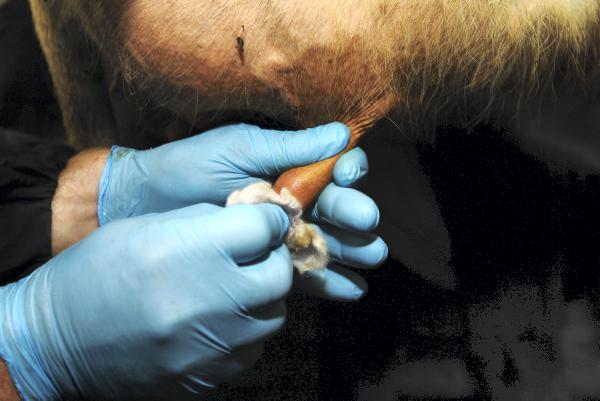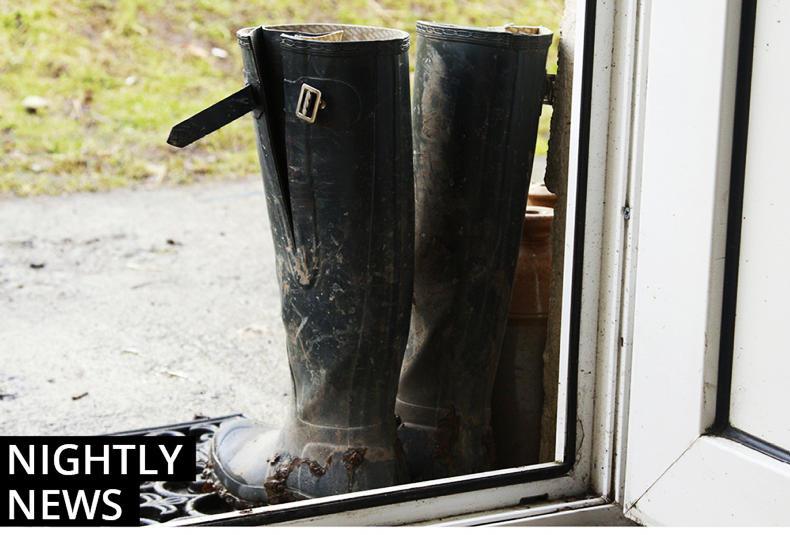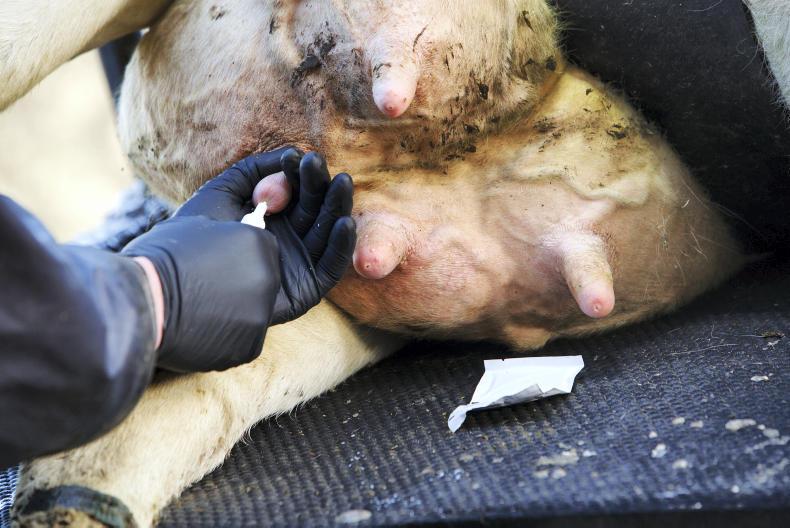Control of somatic cell count (SCC) for 2016 begins now, with an early milk recording before mid-March prior to all the cows calving.
Waiting for all the cows to calve will result in less information, a delay in treatment and culling decisions, giving a poorer overall outcome.
Early milk recording is a key requirement for establishing:
1. New infections in the dry period in cows.
2. SCC for first-calved heifers.
3. Cure rate achieved in the dry period.
4. Identify cows and heifers to treat early in lactation to achieve a good outcome and protect the herd.
5. Identify cows to cull immediately in order to protect the herd.
1New infections in the dry period in cows (See report 1)
An early milk recording is key to establishing the number of new infections in the dry period.
The aim is to have less than 10% of cows (less than one in 10) having an SCC greater than 200,000 in the first milk recording after calving that had a low SCC at dry-off, ideally none.
In this herd shown in Report 1, eight of the 24 (33%) cows calved had an SCC greater than (>) 200,000 and had less than 200,000 (<) at dry-off.
This needs investigation in the following areas:
dry-off procedure adopted;hygiene in the two weeks post dry
off;hygiene in the two weeks pre-calving;housing cleanliness.2First-calved heifers SCC
An early milk recording is key to establishing the SCC of first-calved heifers. Early identification will ensure more effective treatment outcomes, to ensure a long herd life of low SCC and reduced culling.
The aim is to have less than 15% of heifers, which is less than one in six heifers with an SCC greater than 200,000 in the first milk recording after calving, ideally none.
In the herd with these reports, nine out of 15 (60%) of heifers calved had an SCC greater than (>) 200,000 in the current recording.
This needs investigation in the following areas:
hygiene in the two weeks pre-calving predominantly;housing cleanliness and heifer routine management, spraying, etc; calving area cleanliness, bullying and time spent there; time and gentle attitude in training heifers to the milking routine; udder oedema (flagging), warts, etc.3Cure rate achieved in the dry period/effectiveness of dry cow therapy
An early milk recording is key to establishing the cure rate achieved in the dry period. The aim is to have a cure rate of 85%.
That is for every seven cows dried off with an SCC over 200,000, we need six of them to be under 200,000 after calving, ideally all of them cured.
In this herd the cure was 40% – only 10 out of 25 cows calved to date were cured in the dry period.
This needs investigation in the following areas:
length of the dry period;dry-off procedure adopted;dry cow therapy;hygiene in the two weeks post dry-off and in the two weeks pre-calving;housing cleanliness.4Identify cows and heifers to treat early in lactation to achieve a good outcome and to protect the remainder of the herd. (See report 2)
Treatment of cows in early lactation that are likely to cure is time and money well spent.
These cows will return to full milk and will not be a source of infection for the other cows in the herd.
Identify these cows as soon as possible and treat rapidly, as early identification will ensure more effective treatment outcomes.
In this herd the following cow and heifer need to be identified for treatment and should respond favourably:
Cow 1175 had an average SCC in 2015 of 48,000, with no test over 250,000 SCC. She now has an SCC of 2,908,000. Heifer 697 has an SCC of 2,339,000.Actions
Do a CMT test and identify the offending quarter.Ideally, do a culture and sensitivity test on the milk sample.Consult your vet and treat symptoms aggressively.5Identify cows to cull immediately in order to protect the herd
Consider culling cows with high SCC in the current lactation who were also high in the previous lactation, despite having been treated in the dry period with antibiotic therapy. In this herd, 956 had an average SCC of 1,204,000 in the previous lactation, with all seven tests over 250,000 cells/ml. She calved down now with an SCC of 1,140, 000, despite receiving dry-cow antibiotic treatment. This cow has a persistently high SCC and is unlikely to cure. However, the main reason for culling her is that she is a major source of infection in the herd and can be responsible for the spread of infection to other cows. These cows, if in good condition after calving, will make €3.20/kg.
Control of somatic cell count (SCC) for 2016 begins now, with an early milk recording before mid-March prior to all the cows calving.
Waiting for all the cows to calve will result in less information, a delay in treatment and culling decisions, giving a poorer overall outcome.
Early milk recording is a key requirement for establishing:
1. New infections in the dry period in cows.
2. SCC for first-calved heifers.
3. Cure rate achieved in the dry period.
4. Identify cows and heifers to treat early in lactation to achieve a good outcome and protect the herd.
5. Identify cows to cull immediately in order to protect the herd.
1New infections in the dry period in cows (See report 1)
An early milk recording is key to establishing the number of new infections in the dry period.
The aim is to have less than 10% of cows (less than one in 10) having an SCC greater than 200,000 in the first milk recording after calving that had a low SCC at dry-off, ideally none.
In this herd shown in Report 1, eight of the 24 (33%) cows calved had an SCC greater than (>) 200,000 and had less than 200,000 (<) at dry-off.
This needs investigation in the following areas:
dry-off procedure adopted;hygiene in the two weeks post dry
off;hygiene in the two weeks pre-calving;housing cleanliness.2First-calved heifers SCC
An early milk recording is key to establishing the SCC of first-calved heifers. Early identification will ensure more effective treatment outcomes, to ensure a long herd life of low SCC and reduced culling.
The aim is to have less than 15% of heifers, which is less than one in six heifers with an SCC greater than 200,000 in the first milk recording after calving, ideally none.
In the herd with these reports, nine out of 15 (60%) of heifers calved had an SCC greater than (>) 200,000 in the current recording.
This needs investigation in the following areas:
hygiene in the two weeks pre-calving predominantly;housing cleanliness and heifer routine management, spraying, etc; calving area cleanliness, bullying and time spent there; time and gentle attitude in training heifers to the milking routine; udder oedema (flagging), warts, etc.3Cure rate achieved in the dry period/effectiveness of dry cow therapy
An early milk recording is key to establishing the cure rate achieved in the dry period. The aim is to have a cure rate of 85%.
That is for every seven cows dried off with an SCC over 200,000, we need six of them to be under 200,000 after calving, ideally all of them cured.
In this herd the cure was 40% – only 10 out of 25 cows calved to date were cured in the dry period.
This needs investigation in the following areas:
length of the dry period;dry-off procedure adopted;dry cow therapy;hygiene in the two weeks post dry-off and in the two weeks pre-calving;housing cleanliness.4Identify cows and heifers to treat early in lactation to achieve a good outcome and to protect the remainder of the herd. (See report 2)
Treatment of cows in early lactation that are likely to cure is time and money well spent.
These cows will return to full milk and will not be a source of infection for the other cows in the herd.
Identify these cows as soon as possible and treat rapidly, as early identification will ensure more effective treatment outcomes.
In this herd the following cow and heifer need to be identified for treatment and should respond favourably:
Cow 1175 had an average SCC in 2015 of 48,000, with no test over 250,000 SCC. She now has an SCC of 2,908,000. Heifer 697 has an SCC of 2,339,000.Actions
Do a CMT test and identify the offending quarter.Ideally, do a culture and sensitivity test on the milk sample.Consult your vet and treat symptoms aggressively.5Identify cows to cull immediately in order to protect the herd
Consider culling cows with high SCC in the current lactation who were also high in the previous lactation, despite having been treated in the dry period with antibiotic therapy. In this herd, 956 had an average SCC of 1,204,000 in the previous lactation, with all seven tests over 250,000 cells/ml. She calved down now with an SCC of 1,140, 000, despite receiving dry-cow antibiotic treatment. This cow has a persistently high SCC and is unlikely to cure. However, the main reason for culling her is that she is a major source of infection in the herd and can be responsible for the spread of infection to other cows. These cows, if in good condition after calving, will make €3.20/kg.












SHARING OPTIONS